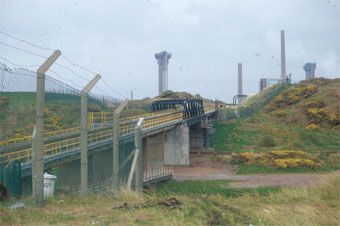
New Managing Director for Bellona Norway
The Board of the Bellona Foundation has appointed former Minister of Climate and the Environment Sveinung Rotevatn as Managing Director of Bellona No...
News

Publish date: June 20, 2004
Written by: Erik Martiniussen
News
The British Environment Agency served the enforcement noticea legal warning to the company to more strictly guard its facilitiesto BNFL on Thursday.
The enforcement notice follows an incident earlier this year when two pieces of a rubber gasket, contaminated with radioactivity, were found on a local beach outside the companys Sellafield site. BNFL operates two nuclear reprocessing plants at Sellafield, both of which discharge large amounts of radioactive wastes to the Irish Sea.
Low radiation levels
Both of the two contaminated gaskets were discovered separately during routine BNFL checks of the Sellafield and Seascale beaches in January and February this year. Investigations by BNFL and the Agency have shown that the items had become detached from the diffuser at the end of one of the operational sealines (sealine 3) used by the company.
Subsequent tests revealed that the radiation levels of both gaskets were found to be low, thus presenting little potential hazard to the public. The gaskets were, however, found to be contaminated above agreed norms.
The enforcement notice was issued because of BNFLs failure to comply with a condition of their operating authorisationwhich is granted by the Environment Agencyto dispose of low level radioactive waste at their Sellafield site in Cumbria.
In a statement Thursday, Andy Mayall, the Environment Agencys nuclear regulator, commented: "Although the risks to the public on this occasion were low, this type of incident is both undesirable and preventable. This will require BNFL to undertake a thorough review of its inspection and maintenance of the discharge pipelines and to make any required improvements."
The Agency will now ask for a review of Sellafields pipeline design, with all work to be completed within an agreed timescale.
A BNFL spokesman said Friday: The discovery of gasket material on the beach was publicly reported by us at the time of the event. Since then, we have carried out a detailed internal inquiry and are already implementing a range of improvements, including all of the work required by the Environment Agency. We are determined to learn from this event to ensure there are no repeat occurs.
Scraps have escape before
Over the last year, BNFL has been working on a £13m project to remove three redundant discharge pipelines. Known as the Sealine Recovery Project, two 10-inch steel pipelines originally laid in 1949, and an 8-inch temporary plastic pipeline, laid around 1990, would be recovered from the seabed over a twelve month period and disposed of in BNFLs onshore licensed low level waste dump at Drigg/Sellafield.
But operations have not been easy. In November last year, lengths of the plastic discharge pipe principally used for evacuating drainage water from the Sellafield site, escaped a seabed containment cage. The dismantled sections were temporarily stored in the seabed cage, waiting to be transported onshore. During stormy weather more than 170 cut pieces broke free from the containment cage and where washed ashore on different local beaches. Four sections where recovered as far away as Isle of Man. One showed slightly higher radiation than normal background levels. The cage originally held 364 lengths of pipe pieces.

The Board of the Bellona Foundation has appointed former Minister of Climate and the Environment Sveinung Rotevatn as Managing Director of Bellona No...

Økokrim, Norway’s authority for investigating and prosecuting economic and environmental crime, has imposed a record fine on Equinor following a comp...

Our op-ed originally appeared in The Moscow Times. For more than three decades, Russia has been burdened with the remains of the Soviet ...

The United Nation’s COP30 global climate negotiations in Belém, Brazil ended this weekend with a watered-down resolution that failed to halt deforest...